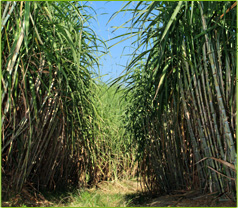History of Sugar

It is not known where sugar originated, but it is thought to have first been used in the Polynesian Islands of the Pacific Ocean over 5,000 years ago.
The Polynesians discovered that the stalks of a giant grass, contained a sweet tasting liquid and could be used in the preparation of food. Sugar was then taken to the coastal areas of India and for many centuries it spread no further.
In 510 BC Darius, the Persian Emperor, arrived to conquer the Indian sub-continent and found that the people used a substance from a plant to sweeten their food.Until then the Persian people had used honey to sweeten food, and so they called sugar cane 'the reed which gives honey without bees'.
In the fourth century BC, Alexander the Great conquered parts of Western Asia and took with him what he called the 'sacred reed'. Before long Ancient Greece, and then Rome, began to import sugar as a luxury product and a medicine.
In the seventh century BC, the Arabs invaded Persia and as part of their loot they took the sugar cane plant.Through invasions, conquests and increased trading links with other countries, sugar cane reached a great number of places, including Egypt, Rhodes, Cyprus, North Africa (Morocco and Tunisia), Southern Spain and Syria.
The Arabs took sugar cane to Spain and Portugal, and because it was a highly profitable crop, both countries became very active in finding new places to grow sugar cane.
In 1493, the explorer Christopher Columbus took sugar cane to the Caribbean Island of Santa Domingo for trial planting. The crop flourished in the hot sunshine, heavy rainfall and fertile soil.
This was a landmark in the history of sugar cane, because, as Columbus reported to Queen Isabella of Spain, it grew faster in the West Indies than anywhere else in the world.
The New World
After Columbus’ voyages to the West Indies, Europeans flocked to this exciting and promising New World. The discovery of how well sugar grew there upset the sugar markets in the Old World and many of the traditional cultivation areas in the Mediterranean were threatened by the competition.
Farmers from Britain, France and Holland made the most of this discovery and grew sugar on plantations in Brazil, Cuba, Mexico and the West Indies. These plantations grew sugar for export and, in the early stages, the local population was employed to tend to the cane.
Later on, because large numbers of workers were necessary, slaves were brought from Africa to farm the plantations. Sugar farming became so profitable that people soon referred to sugar as “white gold”, because owning a sugar plantation was said to be like owning a gold mine.
Sugar in Britain
In Britain, and throughout most of Europe, honey was the ingredient used to sweeten food.The first Britons to taste cane sugar were probably Christian soldiers called Crusaders who fought Muslims in the first Crusade to Syria in 1099.As cane could not grow in the British climate, sugar was not available to the people of Britain until trading and transport had developed sufficiently for sugar to be brought into the country.
It is reported that the household of Henry III was using sugar in 1264, but not until 1319 was sugar in more general use in Britain. It was sold at two shillings a pound (or approximately £50 in today’s money) and was therefore a luxury enjoyed by very few people.
Sugar was such a valuable commodity that it was kept in specially adapted tea caddies which would be locked.
Britain took Jamaica and other parts of the West Indies from Spain in 1655 and from then on became more involved in the sugar industry. By 1750 there were 120 British refining factories, producing 30,000 tonnes of sugar a year from sugar cane. Sugar was heavily taxed and by 1815 the British government had collected a total of £3 million in sugar duties.
In 1874 the prime minister, William Gladstone, removed the tax and sugar could then be afforded by many more British people.
All this time sugar beet was unknown as a source of sugar. Beet has been grown for food and fodder since ancient times. However, it was not until 1747 that Andreas Marggraf, a German chemist, succeeded in extracting sugar from beet in a form which could be used in cooking.
This crop was highly suited to the temperate climate of Europe.
Cane sugar continued to be the main source of sugar in Europe until the Napoleonic Wars, which took place between France and Britain from 1793-1815.
During this period the British Navy blockaded French ports preventing goods from being imported. The farming of sugar beet then developed rapidly on mainland Europe in order to replace cane sugar.
Once it was found that the crop grew well in European climates, sugar from beet began to rival sugar from cane and, by 1880, beet was the main source of sugar in Europe. Another factor which encouraged the increase in European sugar beet farming was the abolition of slavery in the West Indies which increased the cost of cane sugar as paid employees rather than slaves were working on the plantations.
Britain’s interest in sugar beet came about during World War I (1914-1918), when the British supply of sugar from cane was greatly reduced as German U-Boats sunk the trading ships. The British Government decided to intervene and began persuading farmers to grow sugar beet. Since then, Britain has produced a proportion of its sugar from this source.